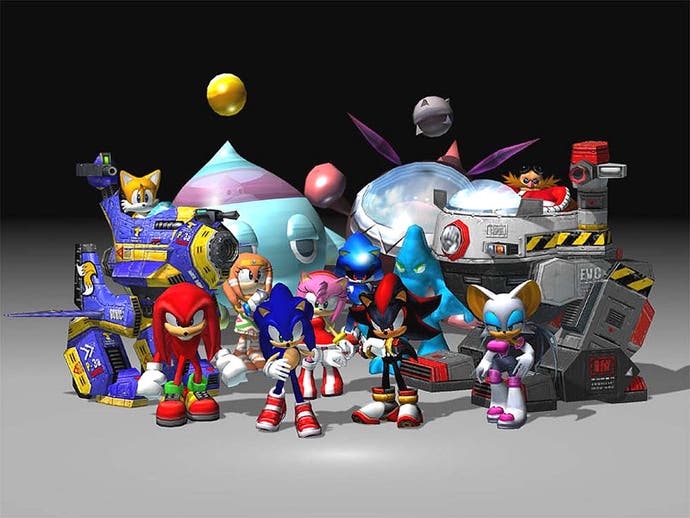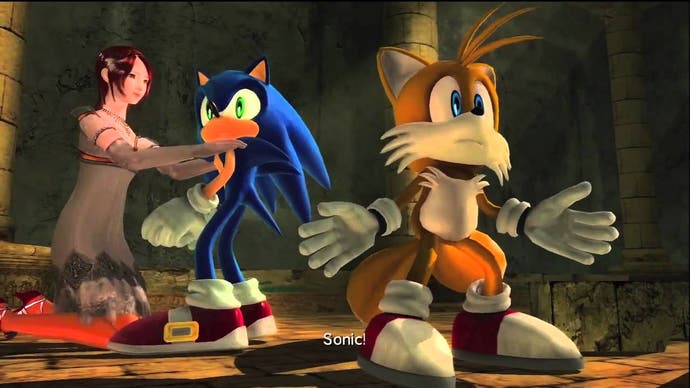Why did 3D Sonic struggle?
Blue blurred.
Why are Sonic's eyes green in Sonic Adventure, the franchise's first serious crack at a fully 3D polygonal platformer? It turns out there's a lovely little story behind that. Ristar creator Yuji Uekawa was the man tasked with revamping Sega's mascot for his debut on Dreamcast. Some of his decisions were practical: shrinking Sonic's enormous, swept-back skull and elongating his limbs, for instance, so that he doesn't look like a fuzzy joystick when viewed from the rear. Others were a touch more poetic. "He is always seeing these green pastures around him, like in Green Hill Zone," Uekawa explains in an interview conducted for Sega's 25th anniversary artbook. "I thought it would be nice to reflect that in his eyes."
Sonic still has green eyes in Sonic Team's forthcoming Sonic Forces, decades later, but we're a long way from those green pastures. What terrible scenes those eyes have beheld! Popping your hips at Kinect in Sonic Free Riders, for instance. Charlie Sheen-grade sitcom sketches in the recent Sonic Boom, an attempt to do for Sonic what the Teen Titans did for DC Comics. The entirety of Sonic the Hedgehog 2006, a game that wants to be Final Fantasy so much it has Sonic snog a princess, as if in hopes of a magical transformation. The Green Hill Zone stands resplendent across its various reincarnations, an Eden from which Sonic is always rapidly departing, but the landscape is otherwise that of D-Day, strewn with dropped rings and the bodies of interchangeable sidekicks or rivals. Perhaps that's why in this year's wonderful Sonic Mania, an officially unofficial fan remake largely content to forget Sonic Adventure ever existed, the blue blur's eyes are black as coal.

I called Sonic's 3D period "20-odd years of slowly accumulating bullshit" in my Mania review. In hindsight that's a little harsh - whatever else he's responsible for, Sonic has given us several decent, generously proportioned 3D action games plus one terrific racing title, and the wider universe thrashed out in novels, comicbooks and cartoons enjoys an impassioned following. But good lord, there has been plenty of rain to go with the shine. Where arch-nemesis Mario broke the mould with Super Mario 64 - then did it again with Super Mario Galaxy - Sonic has never really had that transcendental hit, the game that establishes an irresistible vocabulary for Sonic games in three dimensions. Instead, the hedgehog has staggered from lousy reinvention to lousy reinvention, with Sega obliged to de-list a large number of Sonic titles from Metacritic to cleanse the brand ahead of Sonic Colors and Sonic 4 in 2010.
How to account for this ramshackle showing, following the giddy highs of the MegaDrive era? One answer is that Sonic's transition to 3D coincides with Sonic's vaunted attitude becoming an attitude problem. The character began life as snarky riposte to Mario's plump, cute-as-a-button innocence and the supposed infantile characterisation of video game avatars at large - a strutting, disdainful star decked out in go-faster trainers. As the critic Zolani Stewart observes in a great analysis at Kotaku, this persona is a typically late '80s/early '90s stab at commodifying youth rebellion, re-routing all those radical teen urges into the act of buying neat footwear or big-brand fast food. It's also largely divorced from the character you play in 16-bit Sonic, whose only real trait is impatience.
As a marketing hook, Sonic's bad boy image was always going to come up short against Mario, because plucky earnestness and whimsy will always enjoy a longer shelf-life than over-compensatory edginess - just ask Poochie from the Simpsons. And yet, Sega has doubled down on the idea, seizing on new hardware as a means to make Sonic the rebel icon ever more the point of playing. 10 years after Sonic Adventure, Sonic and the Black Knight would open with Sonic spinning chilli dogs on his fingers like six-shooters while staring down King Arthur. Among the great joys of Mania is to belatedly remember that Sonic wasn't always this obnoxious - directed by Tyson Hesse, one of the artists behind the scintillating Sonic the Comic series, the intro animations portray the hog as brash yet also goofy and crucially, voiceless.

Sonic Adventure also saw the beginnings of both a wayward commitment to narrative sprawl and an extended flirtation with other genres. Tasked with upselling the Dreamcast's capabilities while rebooting Sonic after his late 90s lull, Sonic Team created an impressive but unwieldy chimera of traditions, with photorealistic locations based on trips to Central America, voiced cutscenes and a creaky ensemble storyline, plus subgames such as Tamagotchi-style Chao breeding and levels that take inspiration from the likes of Panzer Dragoon. In the process, it inevitably lost sight of what made the 2D games special - the thrill of precisely navigating gorgeous, hazardous, multiple-route levels at speed. Super Mario 64 is a similarly gigantic and ornate work, but one unified around the capabilities of a single character - a game dedicated to teasing ever more ingenious applications out of Mario's arsenal of triple-jumps, wall kicks, dives, slams and slides, where Adventure's experiments, good and bad, are all compartmentalised, sealed off from one another in the hands of its six playable characters or consigned to individual stages.
If the Mario 64 comparison remains damning, Sonic Team arguably faced more of an uphill challenge than Nintendo when adapting its 2D platforming portfolio. The classic Sonic games are as much homages to pinball tables as they are platformers - consider the flippers, bumpers, lanes and wormholes of Sonic 2's legendary Casino Night Zone. They ask you to develop a feel for momentum and the kinetic possibilities of different terrain types where rivals merely ask you to think about how high your character can jump. They are games you play with your nerve endings, sixth-sensing the difference between a leap that ends in disaster and a leap that carries you over a terrain trap, up a ramp to a clutch of rings. If building a 3D platformer around the turn of the century was very much like taking your first steps into a different reality, Sonic's heritage required that its creators do so at a sprint. Translating that peculiar blend of momentum and coordination into 3D, with all the extra complications in terms of depth perception and degrees of movement, is a problem that every Sonic game to date has wrestled with and none, to my mind, have really solved.
At times Sonic's developers have borrowed from competitors, the standout being Sonic: Lost World, a dodgy cover version of Super Mario Galaxy in which stages are made up of drifting tubes, rings and planetoids. Often, they've sought to amplify the character's combat prowess - Sonic Unleashed gave us a weirdly elastic "werehog", Shadow the Hedgehog (properly known as Shadow the Damn Hedgehog) dabbled in gunplay, and Sonic and the Black Knight encumbered you with a talking sword. The key trend, however, has been relentless acceleration. The last few outings often feel less like platformers and more like arcade shoot 'em ups - twitchy, all-but-on-rails affairs that offer lashings of sparkly objects to hoover up and loads of blissfully worked screen furniture to blast through.

Sonic Adventure 2 introduced rail grinding, which keeps you barrelling along while taking charge of the camera and usefully limiting your options to jumping or changing rail - just the thing when, for instance, you want the course to double-back on itself without giving the player whiplash. The Adventure series also pioneered a homing attack, allowing Sonic to punch out groups of enemies like a boxer working the speed bag, leapfrog from one aerial foe to the next, or drop-kick himself straight into an out-of-control tumble. The stages - many of them jaw-dropping of conceit, with the orbiting theme park from Sonic Colors a recent treasure - have become saturated with boosters or power-ups that trigger maximum warp, and light on props, such as pop-out ledges or those tantalising sealed-off ring chambers, that demand a bit of finesse. In Sonic Generations, in particular, the velocity is occasionally such that all you can make out is a tunnel of smeared, disintegrating colours - a throwback to those moments in the 16-bit Sonics when Sonic threatens to leave even the scrolling camera behind.
Sonic Generations, of course, styles itself a game that reconciles eras and traditions - it lets you tackle imperfect but recognisable versions of classic stages as a portly 3D manifestation of the original Sonic sprite. Pleasingly, you can also fly through versions of those stages as modern-day Sonic, green eyes and all - experiencing the Chemical Plant Zone's opening double-helix runways head-on, or hurtling through rather than around the loops in Green Hill Zone. Generations is probably the best 3D Sonic game - amongst other things, its use of challenges to spur replay is quietly inspired, and wouldn't look out of place in Sonic Mania - but its premise is also an admission of defeat, weaving the two epochs together only to remind us of their profound differences. The past and present Sonics may gallop side by side but (cutscenes obviously excepted) never shall the twain meet. Sonic Forces - which Martin saw in July, much to his distress - picks up where Generations left off, folding in a player-created character for good measure. It's a hell of a twist to end on: in seeking to revive the glory days, Sonic has become his own sidekick.

